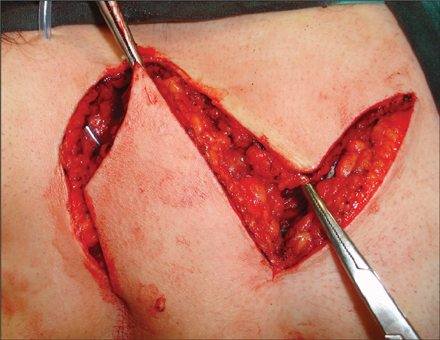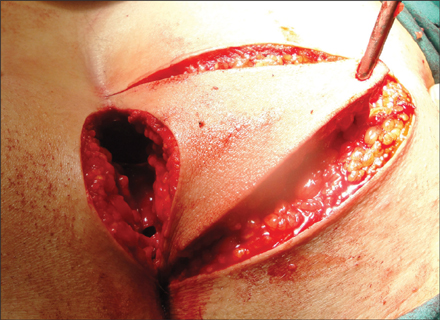J Korean Surg Soc.
2013 Aug;85(2):63-67. 10.4174/jkss.2013.85.2.63.
Comparision of the Limberg flap with the V-Y flap technique in the treatment of pilonidal disease
- Affiliations
-
- 1Department of General Surgery, Sakarya University Faculty of Medicine, Sakarya, Turkey. fatihaltintoprak@yahoo.com
- 2Department of General Surgery, Sakarya University Research and Educational Hospital, Sakarya, Turkey.
- 3Department of General Surgery, Afyon Kocatepe University Faculty of Medicine, Afyonkarahisar, Turkey.
- KMID: 2212518
- DOI: http://doi.org/10.4174/jkss.2013.85.2.63
Abstract
- PURPOSE
In this study, we investigated whether there is a factor that can aid determi nation of the preferred technique by comparing the early and late results of two different surgical techniques for the treatment of pilonidal sinus.
METHODS
The medical records of 176 patients in whom the Limberg flap (LF) or V-Y flap techniques were applied for reconstruction after the excision were evaluated retrospectively.
RESULTS
The development rates of postoperative hematoma, wound separation, wound infection, and seroma were 2.8%, 5.1%, 5.6%, and 6.3%, respectively, while total flap necrosis was not observed in any patient. Return to daily activities was achieved after a mean of 17.1 days (13 to 21 days) days in the LF group and 32.7 days (18 to 47 days) in the V-Y flap group. During the average follow-up of 65 months (36 to 110 months), nine patients (5.1%) developed recurrent disease. There was no difference between the two groups with respect to early surgical complications (P = 0.286) or disease recurrence (P = 0.094), whereas the resumption of daily activities was longer in patients with a V-Y flap (P < 0.001).
CONCLUSION
The early postoperative and long-term results of the LF and V-Y flap techniques for the treatment of pilonidal sinus were similar. Because the resumption of daily activities at work is achieved later in patients undergoing the V-Y flap compared with the LF technique, patients' employment (or position in working life) must be considered when determining the most appropriate surgical technique.
Keyword
MeSH Terms
Figure
Reference
-
1. Surrell JA. Pilonidal disease. Surg Clin North Am. 1994. 74:1309–1315.2. Karydakis GE. Easy and successful treatment of pilonidal sinus after explanation of its causative process. Aust N Z J Surg. 1992. 62:385–389.3. Daphan C, Tekelioglu MH, Sayilgan C. Limberg flap repair for pilonidal sinus disease. Dis Colon Rectum. 2004. 47:233–237.4. Akinci OF, Coskun A, Uzunkoy A. Simple and effective surgical treatment of pilonidal sinus: asymmetric excision and primary closure using suction drain and subcuticular skin closure. Dis Colon Rectum. 2000. 43:701–706.5. al-Hassan HK, Francis IM, Neglen P. Primary closure or secondary granulation after excision of pilonidal sinus? Acta Chir Scand. 1990. 156:695–699.6. Ertan T, Koc M, Gocmen E, Aslar AK, Keskek M, Kilic M. Does technique alter quality of life after pilonidal sinus surgery? Am J Surg. 2005. 190:388–392.7. Urhan MK, Kucukel F, Topgul K, Ozer I, Sari S. Rhomboid excision and Limberg flap for managing pilonidal sinus: results of 102 cases. Dis Colon Rectum. 2002. 45:656–659.8. Holm J, Hulten L. Simple primary closure for pilonidal disease. Acta Chir Scand. 1970. 136:537–540.9. Khanna A, Rombeau JL. Pilonidal disease. Clin Colon Rectal Surg. 2011. 24:46–53.10. Sharma PP. Multiple Z-plasty in pilonidal sinus: a new technique under local anesthesia. World J Surg. 2006. 30:2261–2265.11. Kim JK, Jeong JC, Lee JB, Jung KH, Bae BK. S-plasty for pilonidal disease: modified primary closure reducing tension. J Korean Surg Soc. 2012. 82:63–69.12. Karydakis GE. New approach to the problem of pilonidal sinus. Lancet. 1973. 2:1414–1415.13. Bascom J. Pilonidal disease: origin from follicles of hairs and results of follicle removal as treatment. Surgery. 1980. 87:567–572.14. el-Khadrawy O, Hashish M, Ismail K, Shalaby H. Outcome of the rhomboid flap for recurrent pilonidal disease. World J Surg. 2009. 33:1064–1068.15. Topgül K, Ozdemir E, Kilic K, Gokbayir H, Ferahkose Z. Long-term results of limberg flap procedure for treatment of pilonidal sinus: a report of 200 cases. Dis Colon Rectum. 2003. 46:1545–1548.16. Unalp HR, Derici H, Kamer E, Nazli O, Onal MA. Lower recurrence rate for Limberg vs. V-Y flap for pilonidal sinus. Dis Colon Rectum. 2007. 50:1436–1444.17. Mentes O, Bagci M, Bilgin T, Ozgul O, Ozdemir M. Limberg flap procedure for pilonidal sinus disease: results of 353 patients. Langenbecks Arch Surg. 2008. 393:185–189.18. Khatri VP, Espinosa MH, Amin AK. Management of recurrent pilonidal sinus by simple V-Y fasciocutaneous flap. Dis Colon Rectum. 1994. 37:1232–1235.19. Saray A, Dirlik M, Caglikulekci M, Turkmenoglu O. Gluteal V-Y advancement fasciocutaneous flap for treatment of chronic pilonidal sinus disease. Scand J Plast Reconstr Surg Hand Surg. 2002. 36:80–84.20. Dýlek ON, Bekereciodlu M. Role of simple V-Y advancement flap in the treatment of complicated pilonidal sinus. Eur J Surg. 1998. 164:961–964.21. Akin M, Gokbayir H, Kilic K, Topgul K, Ozdemir E, Ferahkose Z. Rhomboid excision and Limberg flap for managing pilonidal sinus: long-term results in 411 patients. Colorectal Dis. 2008. 10:945–948.22. Schoeller T, Wechselberger G, Otto A, Papp C. Definite surgical treatment of complicated recurrent pilonidal disease with a modified fasciocutaneous V-Y advancement flap. Surgery. 1997. 121:258–263.
- Full Text Links
- Actions
-
Cited
- CITED
-
- Close
- Share
- Similar articles
-
- Limberg flap reconstruction for sacrococcygeal pilonidal sinus disease with and without acute abscess: Our experience and a review of the literature
- Effect of Modified Rhomboid Excision and Limberg Flap for the Treatment of Recurrent Pilonodal Sinus
- Comparative analysis of the same technique-the same surgeon approach in the surgical treatment of pilonidal sinus disease: a retrospective cohort study
- Comparison of Limberg flap and excision and primary closure of pilonidal sinus disease, in terms of quality of life and complications
- Comparison of Limberg Flap and Karydakis Flap Surgery for the Treatment of Patients With Pilonidal Sinus Disease: A Single-Blinded Parallel Randomized Study



